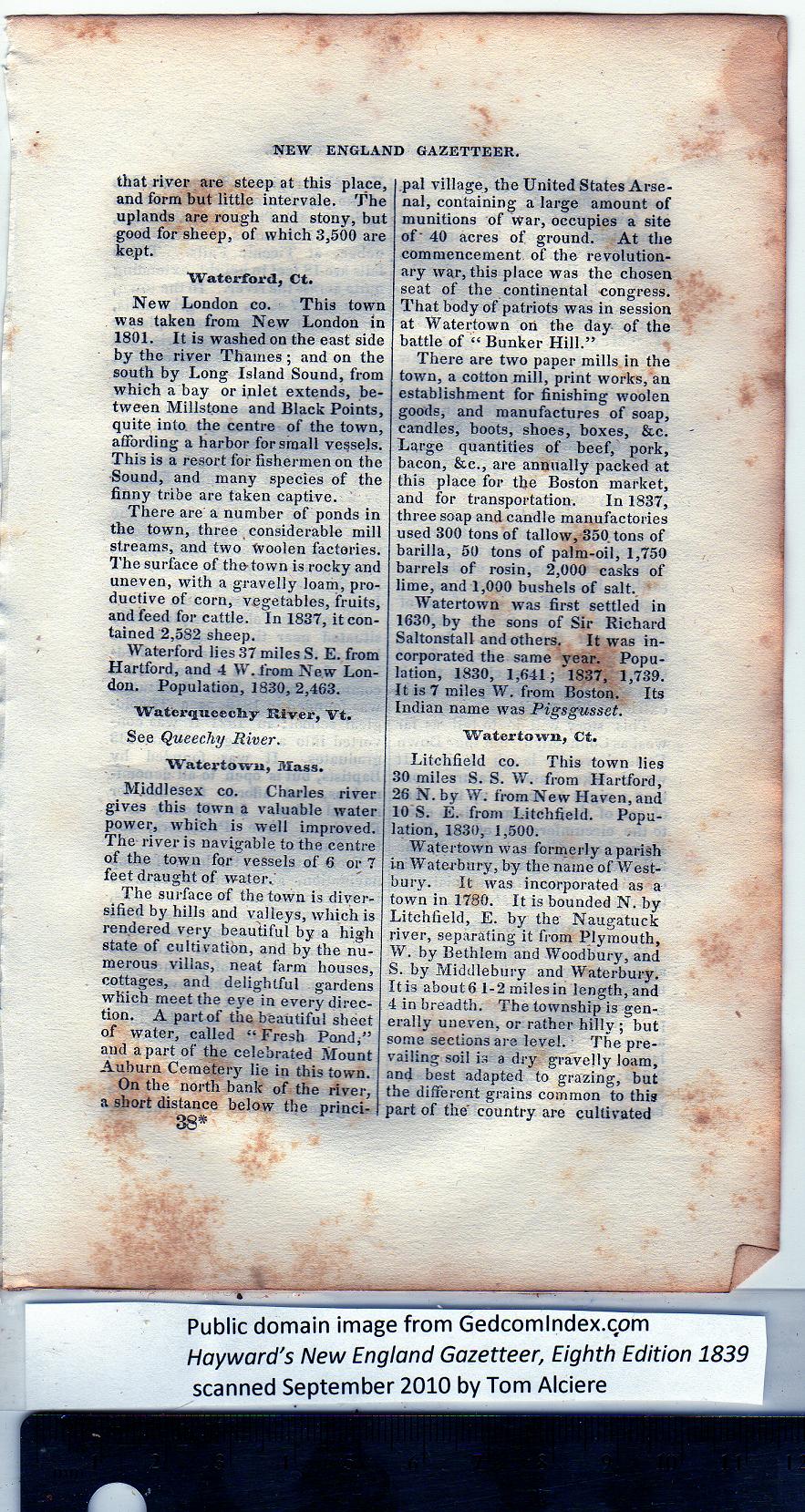|
that river are steep at this place,
and form but little intervale. The
uplands are rough and stony, but
good for sheep, of which 3,500 are
kept.
Waterford, Ct.
New London co. This town
was taken from New London in
1801. It is washed on the east side
by the river Thames ; and on the
south by Long Island Sound, from
which a bay or inlet extends, be-
tween Millstone and Black Points,
quite into the centre of the town,
affording a harbor for small vessels.
This is a resort for fishermen on the
SouQd, and many species of the
finny tribe are taken captive.
There are a number of ponds in
the town, three considerable mill
streams, and two tvoolen factories.
The surface of the-town is rocky and
uneven, with a gravelly loam, pro-
ductive of corn, vegetables, fruits,
and feed for cattle. In 1837, it con-
tained 2,582 sheep.
Waterford lies 37 miles S. E. from
Hartford, and 4 W. from New Lon-
don. Population, 1830, 2,463.
Waterqneecliy River, Vt.
See Queechy River.
"Watertown, Mass.
Middlesex co. Charles river
gives this town a valuable water
power, which is well improved.
The river is navigable to the centre
of the town for vessels of 6 or 7
feet draught of water.
The surface of the town is diver-
sified by hills and valleys, which is
rendered very beautiful by a high
state of cultivation, and by the nu-
merous villas, neat farm houses,
cottages, and delightful gardens
which meet the eye in every direc-
tion. A partof the beautiful sheet
of water, called “Fresh Pond,”
and apart of the celebrated Mount
Auburn Cemetery lie in this town.
On the north bank of the river,
a short distance below the princi-
38* |
pal village, the United States Arse-
nal, containing a large amount of
munitions of war, occupies a site
of 40 acres of ground. At the
commencement of the revolution-
ary war, this place was the chosen
seat of the continental congress.
That body of patriots was in session
at Watertown on the day of the
battle of “ Bunker Hill.”
There are two paper mills in the
town, a cotton mill, print works, an
establishment for finishing woolen
goods, and manufactures of soap,
candles, boots, shoes, boxes, &c.
Large quantities of beef, pork,
bacon, &c., are annually packed at
this place for the Boston market,
and for transportation. In 1837,
three soap and candle manufactories
used 300 tons of tallow, 350 tons of
barilla, 50 tons of palm-oil, 1,750
barrels of rosin, 2,000 casks of
lime, and 1,000 bushels of salt.
Watertown was first settled in
1630, by the sons of Sir Richard
Saltonstall and others. It was in-
corporated the same vear. Popu-
lation, 1830, 1,641; 1837, 1,739.
It is 7 miles W. from Boston. Its
Indian name was Pigsgusset.
Watertown, Ct.
Litchfield co. This town lies
30 miles S. S. W. from Hartford,
26 N.by W. from New Haven, and
10 S. E. from Litchfield. Popu-
lation, 1830, 1,500.
Watertown was formerly aparish
in Waterbury, by the name of West-
bury. It was incorporated as a
town in 1780. It is bounded N. by
Litchfield, E. by the Naugatuck
river, separating it from Plymouth,
W. by Bethlem and Woodbury, and
S. by Middlebury and Waterbury.
Itis about6 l-2milesin length,and
4 in breadth. The township is gen-
erally uneven, or rather hilly ; but
some sections are level. The pre-
vailing soil is a dry gravejly loam,
aDd best adapted to grazing, but
the different grains common to this
part of the' country are cultivated |
